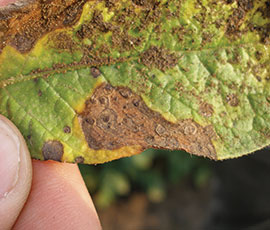Dual action spray tackles alternaria and potato blight

A single treatment is set to offer control of two troublesome diseases in potato crops for next season.
A fungicide spray to tackle both alternaria and potato blight is being launched, claiming a disease control breakthrough for potato growers.
The new product from Syngenta, Amphore Plus, will allow growers to control the two problematic diseases, including all strains of alternaria, and could become the centre of many blight spray programmes.
Syngenta field technical manager Stephen Williams told delegates at the British Potato 2013 conference that the prevention of these diseases is critical and the timing of Amphore Plus allows growers to stay ahead of the disease.
Areas where alternaria is becoming more of an issue will benefit from the new product, which combines one of the most widely used blight actives – mandipropamid – with a new active ingredient for potatoes – difenoconazole.
Up until now most products only target either blight or alternaria, according to Mr Williams.
The soluble concentrate of 0.6l/ha delivers the same amount of active ingredient as the widely used blight spray Revus with 150g of mandipropamid, along with an additional 150g of difenoconazole.
“It is highly active against alternaria but it is a difficult pathogen to control so dosage is everything. We believe with that extra active, we can get on top of the disease,” he said.
Calculating the cost of alternaria attack, Mr Williams warned that potato crops hit by infection suffer rapid green loss and early senescence, which could reduce yield by up to 30%.
“Furthermore, as a result of early senescence, the smaller tubers can fail to meet contract specification,” he said.
“Irregular dry matter from immature crops affects quality and sugar levels, which adversely affect processing quality, while tuber damage increases skin defects and reduces crop value,” Mr Williams added.
A risk assessment will be critical for growers who want to stay on top of the two diseases, with Mr Williams stressing the importance of preventing the disease rather than curing it.
“If you see the weather conditions are there, warm and humid, then there is a high risk so it is critical to get on preventatively,” he explained.
Wimbledon week gives growers a rough guide for when to get on with spraying and when crops are under some of the highest pressure, according to Mr Williams.
Differences in varietal susceptibility will have also have to be taken into consideration, with the new product becoming especially important on varieties such as Markies and Ramos where alternaria can be a big problem.
Independent potato specialist John Sarup says the problem of alternaria, which has been increasing over the years, will certainly be helped this new product, at a time when growers are trying to cut costs.
“With farm incomes coming under increasing pressure, growers are tightening on their fertiliser inputs, which can lead to stressed crops. On vigorous growing varieties such as Markies if the nitrogen is cut too much it leaves it open to the threat of alternaria,” he said.
Another part of the risk assessment should include looking at whether there is a history of alternaria and Mr Sarup says taking in all the different aspects will help in the fight against the disease.
Three applications will cover growers through the highest risk period, however growers have some flexibility in their spray programme.
“You can alternate or block them together. We have no real preference,” said Mr Williams.
Syngenta has also developed a new prototype potato spray nozzle which, it hopes, will enhance consistent deposition through the crop canopy, as well as improved drift control.
Available in 2014 and developed as part of the Syngenta Potato Science initiative, trial results showed the nozzle applied 15% more spray in the mid-canopy, compared with the current Syngenta potato nozzle and up to 35% more than other angled nozzles.
Syngenta application specialist Ben Magri says the trial results are very promising, offering good penetration throughout the canopy.
In the initial trials, the new nozzles were operated to alternately face forwards and backwards along the spray boom; a configuration Mr Magri believes would optimise spray penetration and minimise the risk of drift.

